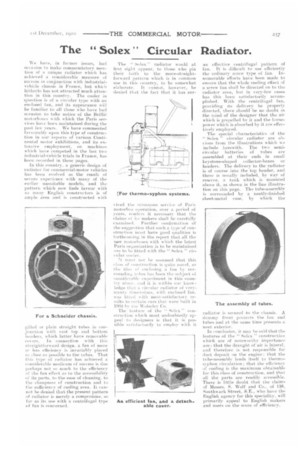The " Solex " Circular Radiator.
Page 5

If you've noticed an error in this article please click here to report it so we can fix it.
'We have, in former issues, had occ-asion to make commendatory of a unique radiator which has achieved a considerable measure of success in conjunction with industrialvehicle chassis in France, but which hitherto has not attracted much attention in this country. The cooler in (piestien is of a circular type with au enclosed fan, and its appearanee
be familiar to all those who have had occasion to take notice of the 13rillie motorbuses with which the Paris .;e1-vices have beeu maintained during the past few years. NV e have commented favourably upon this type of construction in our reports of various Continental motor exhibitions, and its extensive employment, on maelliT1PS which have competed in the. last two industrial-vehicle trials in Prance, has been recorded in these pages.
In this couaLry, a generie design of radiator for commercial-motor vehicles has been evolved as the result of severe experience with many of the earlierunsuitable models, and the pattern whick now finds favour with So many English constructors is of ample area and is constructed with
gilled or plain straight tubes in conjunction with cast top and bottom Ii eaders., which latter have removable eovers. iii connection with this St raightforward design, a fan of more or less efficiency is invariably plaved as (-lose as possible to the tubes. That this type of radiator has athieved a roosiderable modicum of SUCCOSS is doe perhaps not 511 much to the efficiency of the fan effect as to the accessilrility of its parts, to the ease of cleaning, to the cheapness of construction and to the sufficiency of cooling area. It cannot he denied that the present pattern of radiator is merely a oompromise. so far as its use with a centrifugal type If fan is concerned.
The " :Solex " radiator would at first sight appear, to thnkse who pin their faith to the more-straightforward pattern which is in common 11St? iii thiS COUntry, to be somewhat elaborate. It cannot, however, be denied that the fact that it has sur vived the strenuous service of PilriS MotOrblIS eration, over 0 period of ICS VS. [TWAT:, it necessary that the claims of its makers shall be carefully examined. Further confirmation of the suggestion that such a type of construction must have good qualities is forthcomingin the report that all the orrow molorhuses with which the latest Paris organization is to be maintained are to he fitted with the " Solex " (irk-1110r cooler.
It must not he inqin Hied that this class of construction is (pike novel, ccs Tile idea or prolosiny, a fan by surrounding, tribes has. been the subject of consideralde experiment in tins coontry almic. and it is within our knoe,ledge that a eireular radiator of veryscanty diii Iensions. with enclosed fan. was lilted 11 th most-satisfactory results to eertain cars that were built ill 1904 lvIi e Weis:cloy Co.
The ieat:lre of the " Solex " construction Is Ii ich must undoubtedly appeal to designers is that it is possible satisfactorily to employ with it
an effective centrifugal pattern of fan. It is difficult to use efficiently the ordinary screw type of fan. Innumerable efforts have been made to ensure that the whole cooling effect of a screw fan shall be directed on to the radiator area, hut in very-few cases has this been satisfactorily accomplished. With the centrifugal fan, providing its delivery be properly directed, there should be no doubt in the mind of the designer' that the air which is propelled by it and the horsepower which is absorbed by it 810 effectively employed.
The special characteristics of the " Solex " circular radiator are obvious from the illustrations which we inelnde herewith. The two semicireular batteries of tubes are assembled at their ends in small keystone-shaped collector-boxes or headers. The delivery to the radiator is of course into the top header, and there is usually included, by way of reserve, a tank which is mounted above it, as shown in the line illustration on this page. The tithe-assembly is surrounded by a neatly-finished sheet-metal ease, by which the radiator is secured to the chassis. A dummy front protects the fait and tubes and at the same time presents a neat exterior.
In conclusion, it may be SAM that the features of -the " Solex " construction Ii hick are of noteworthy importance are that the draught of air is lateral, and therefore is not responsible for dtist deposit on the engine: that the tube-assembly lends itself to thermosyphon circulation; that the efficiency of cooling is the maximum obtainable For this class of construction. and that all the parts are readily accessible. There is little doubt that the claims of Messrs. S. Wolf and Co.. of 138, Sontlinark Street, S.E., who have the English agency for this speciality, will primarily appeal to English makers and users on the score of efficiency.




















